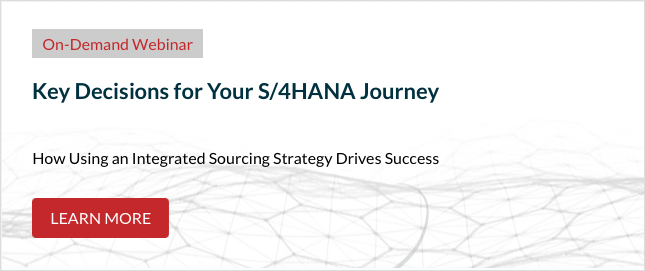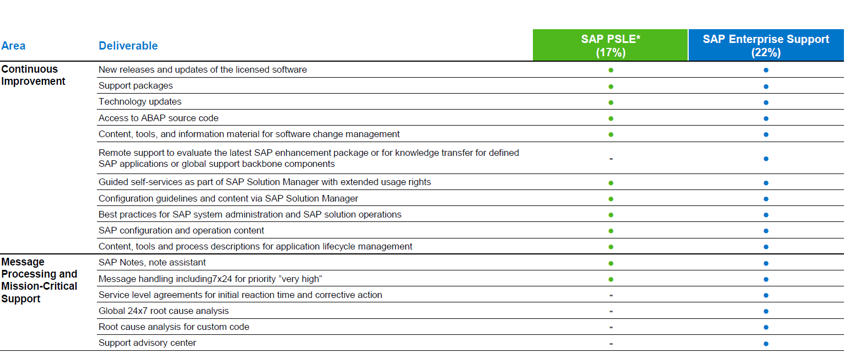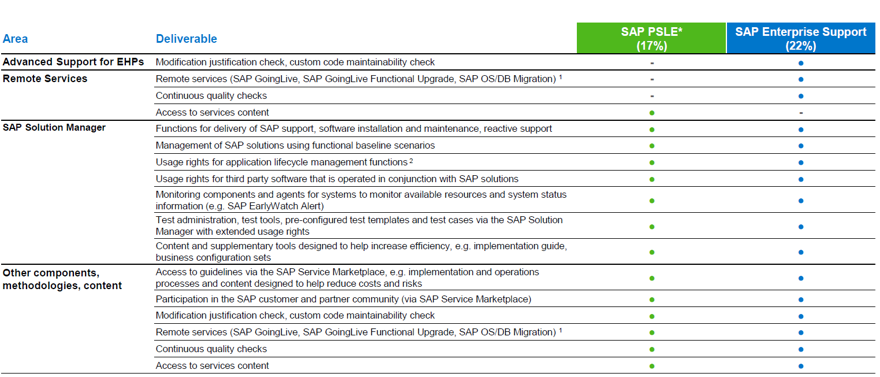- Devin Djerf
- Reading Time: 4 minutes

When determining what level of SAP support you will require going forward, it is important to consider what level of support you are currently operating under and whether there is an opportunity to switch to Product Support for Large Enterprises (PSLE) based on overall spend with SAP. If there is, is this truly the most beneficial switch for your business?
If you determine that PSLE is the best option going forward, it is also imperative to lock down certain commercial elements when negotiating support, such as Support Protections. Here, I will cover what SAP’s support options are, how to determine which support is best for your company, and what to negotiate once you’ve decided.
A Brief Overview of SAP’s Support Models
SAP offers three support options:
- Enterprise Support: Enterprise Support is SAP’s most popular support option and is available to all SAP customers, small or large. SAP offers Enterprise Support at 22% of Annual Maintenance Base and has no minimum threshold requirements.
- Standard Support: Standard Support is also offered to all SAP customers. Standard Support is priced at 19% of Annual Maintenance Base and has no minimum threshold requirements. This is the least common support model we see customers opting for.
- PSLE Support: As the name would suggest PSLE is available to SAP’s largest customers. PSLE is offered at 17% of Annual Maintenance Base and does require a threshold requirement based on total investment spend with SAP.
Of these options, Enterprise and PSLE are the most common among SAP customers.
If SAP positions PSLE as an opportunity for your company during SAP negotiations, the fact that you will be paying a 17% factor for support in lieu of 22% will seem compelling. But before your company starts calculating potential savings, consider the following:
Will PSLE Meet Your Needs?
There are several differences in the level of support that SAP offers between Enterprise and PSLE options, such as reduced deliverables. Below is a list comparing Enterprise and PSLE :
If you decide to go with PSLE, you forgo certain deliverables such as Service Level Agreements for initial reaction time with corrective action, global root cause analysis and the support advisory center. We recommend taking an opportunity to solicit clarification from SAP and understand the corresponding reduction in support under PSLE.
Are You Comfortable Committing to a Certain Level of Spend in Perpetuity?
Once you make the commitment to PSLE, your agreement with SAP will contractually bind you to a certain level of spend each year. If you drop below that level of spend, you will expeditiously lose your right to the reduction in the support factor by 5%. Therefore, it is important that your company is comfortable committing to that level of spend with SAP in perpetuity.
For example, if your On-Premise relationship and MaxAttention relationship make up your commitment and you chose not to renew MaxAttention, you will need to make up that spend elsewhere, like with Cloud spend.
Are You Leveraging This Commitment to Renegotiate Your Agreement?
SAP typically proposes PSLE when a customer is in the throes of a negotiation, and it can be positioned as an opportunity to sweeten the deal and reduce annual maintenance fees. Despite this tactic, we recommend revisiting your SAP footprint to achieve more competitive commercial terms.
When you make the commitment to PSLE, it should not be the only commercial item on the table. Customers should leverage this opportunity to renegotiate commercial constructs like future discount and price protections or exchange rights. Additionally, if customers are considering moving to the cloud at some point in the future, SAP offers extension programs to ease the transition to cloud.
Making the Switch to PSLE
The first thing to review is your prior and current agreement landscape with SAP. Are you currently operating at the 17% annual support, or has it been positioned in the past?
Similar to how SAP positions other commercial offerings, when it positions PSLE, it does so in a way to make it appear non-negotiable. However, based on our experience supporting and negotiating many of our client’s conversions to PSLE, PSLE is in fact negotiable just like every other commercial offering from SAP. SAP has agreed to lower levels of commitment to achieve the PSLE threshold.
It is important for clients to assess spend if they plan to move from ECC to S/4HANA. The various support models for transitioning from ECC to S/4HANA are intended to provide the following incentives/benefits:
- Unlock the value of the SAP S/4HANA cloud transition
- Provide a tailored, goal-based engagement plan to enable successful completion of the S/4HANA transition
- Provide the customer with relevant SAP Best Practices to minimize disruptions during the S/4HANA transition
- Leverage on-demand support expertise at the customers’ own pace of implementation
- Reduce total cost of implementation by mitigating risks and validating quality (e.g., quality checks and technical optimization)
Customers can also determine their overall spend with SAP through its applicable Cloud Services (e.g., SAP S/4HANA Cloud, SuccessFactors, Ariba, IBP, etc.) which would add to the threshold requirement.
We have also seen clients leverage PSLE over the course of many years, depending on their relationship with SAP. In this case, it is important to position support lock protections that holds the PSLE percentage at 17% for an extended period. This is done on a transaction-by-transaction basis.
In the end, not every company will see a proposal from SAP to make the change to PSLE. But if you are considering transitioning to PSLE, keep in mind that it is certainly a commitment that cannot be taken lightly – it includes an obligation to a certain level of spending in perpetuity.
As with many other negotiation strategies with SAP, it is critical for businesses to do their due diligence and determine what is the best course of action going forward with SAP.



